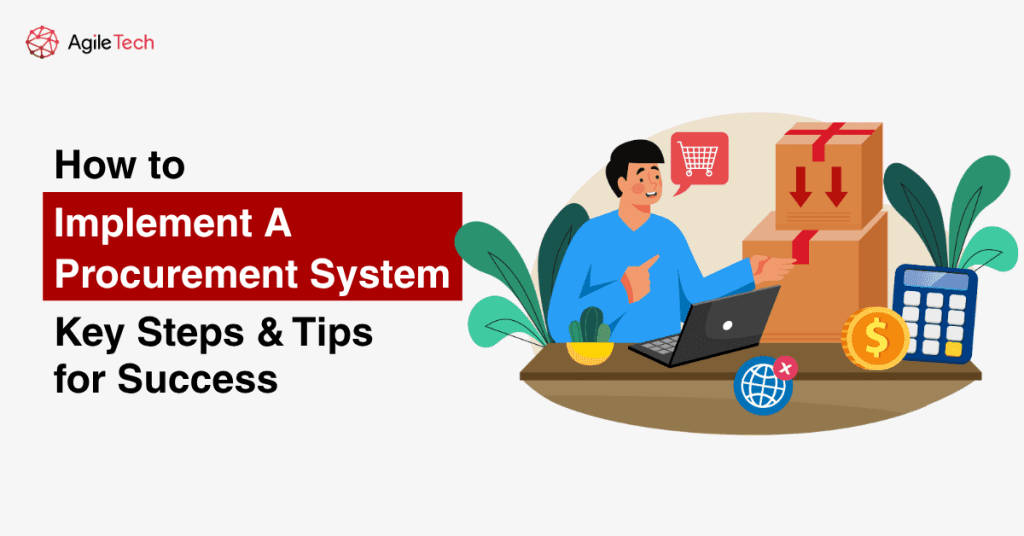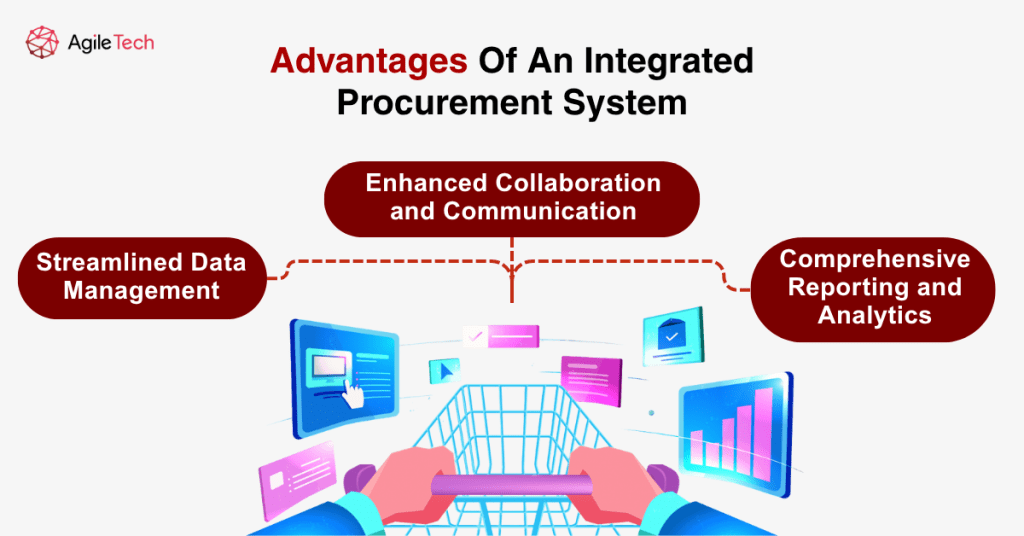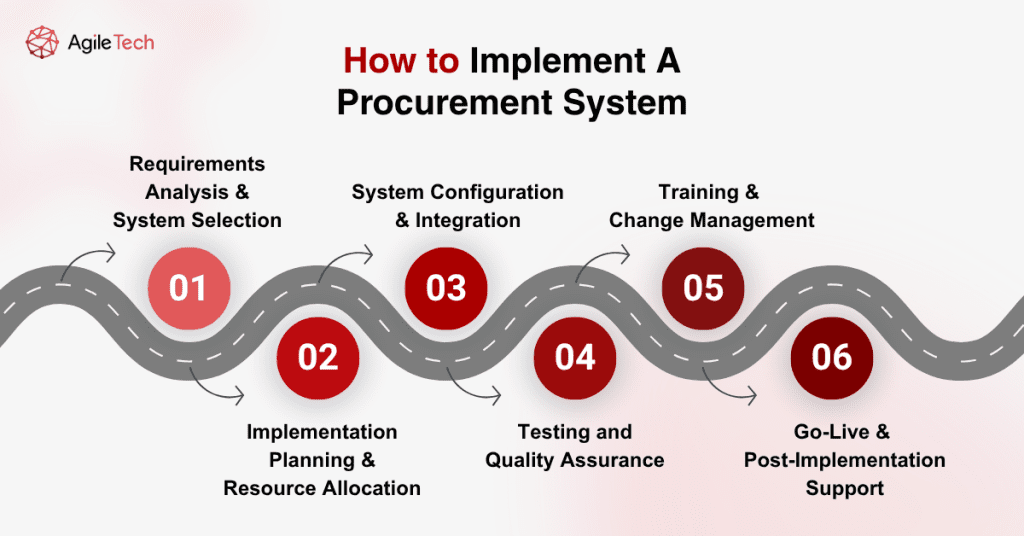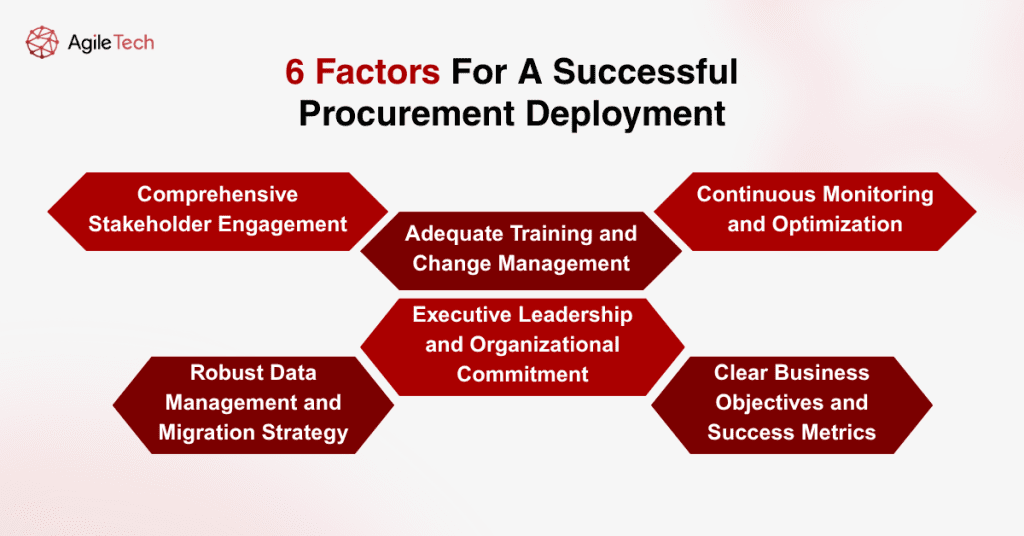How to Implement A Procurement System: Key Steps & Tips for Success
Implementing a procurement system transforms business operations by streamlining purchasing processes, reducing costs, and improving vendor management. This comprehensive guide provides actionable insights for successful procurement process implementation, covering essential steps, critical success factors, and integration strategies to maximize your investment and operational efficiency.

- 1. What Is a Procurement System?
- 2. Why Is Implementing a Procurement System Important?
- 3. Advantages Of An Integrated Procurement System
- 4. How to Implement A Procurement System: A Step-by-step Guide
- 5. 6 Factors For A Successful Procurement Deployment
- 6. How ERP Supports the Procurement Process Implementation
- 7. AgileTech – Custom Procurement Software Provider
1. What Is a Procurement System?
A procurement system serves as the technological backbone for managing an organization’s purchasing activities, from initial vendor identification through final payment processing. This comprehensive solution automates and streamlines the entire procurement lifecycle, providing businesses with enhanced visibility, control, and efficiency in their purchasing operations.
Modern procurement systems integrate multiple functionalities including purchase requisition management, vendor relationship management, contract administration, invoice processing, and spend analytics. These systems transform traditional paper-based processes into digital workflows that reduce manual errors, accelerate approval cycles, and provide real-time insights into procurement performance.
2. Why Is Implementing a Procurement System Important?
Organizations across industries recognize that effective procurement process implementation delivers significant competitive advantages and operational improvements. The modern business environment demands greater efficiency, transparency, and cost control in procurement activities, making system implementation essential for sustainable growth.
Enhanced Cost Control and Savings
Systematic procurement implementation provides organizations with unprecedented visibility into their spending patterns and supplier relationships. This transparency enables procurement teams to identify cost reduction opportunities, negotiate better contract terms, and eliminate maverick spending that occurs outside established procurement channels.
Advanced procurement systems leverage data analytics to provide detailed spend analysis, supplier performance metrics, and market intelligence that support strategic sourcing decisions. Organizations typically achieve cost savings of 5-15% within the first year of procurement process implementation through improved negotiation capabilities, contract compliance, and spend consolidation.
Improved Operational Efficiency
Manual procurement processes consume significant administrative resources and create bottlenecks that slow business operations. Implementing a comprehensive procurement system eliminates repetitive manual tasks, accelerates approval workflows, and reduces processing times from days to hours.
Automated purchase requisition routing ensures that requests reach appropriate approvers quickly while maintaining proper authorization controls. Electronic invoicing and three-way matching capabilities reduce accounts payable processing time and improve vendor relationships through faster payment cycles. These efficiency improvements enable procurement teams to focus on strategic activities rather than administrative tasks.
Risk Mitigation and Compliance
Modern procurement systems provide robust compliance frameworks that help organizations manage regulatory requirements, internal policies, and contractual obligations. Automated approval workflows ensure that all purchases follow established authorization protocols while maintaining complete audit trails for compliance reporting.
Vendor risk assessment capabilities enable procurement teams to evaluate supplier financial stability, compliance history, and performance metrics before establishing business relationships. Contract management features provide automated alerts for renewal dates, compliance requirements, and performance milestones, reducing the risk of costly contract breaches or missed opportunities.
3. Advantages Of An Integrated Procurement System
Integrated procurement solutions offer substantial benefits over fragmented point solutions by creating seamless data flow between procurement processes and other business systems. Cloud-based procurement solutions particularly excel in providing this integration while offering enhanced scalability and accessibility.

3.1. Streamlined Data Management
Integrated procurement systems create a single source of truth for all procurement-related information, eliminating inconsistencies that arise from maintaining multiple databases. Vendor information, contract terms, pricing agreements, and performance metrics are automatically synchronized across all system modules, ensuring data accuracy and reducing administrative overhead.
Real-time data integration enables procurement teams to make informed decisions based on current information rather than outdated reports. This capability is particularly valuable for strategic sourcing activities where market conditions and supplier capabilities change rapidly.
3.2. Enhanced Collaboration and Communication
Integration capabilities extend beyond internal systems to include supplier portals and customer interfaces that facilitate better collaboration throughout the procurement process. Suppliers can access real-time order status, submit invoices electronically, and respond to requests for proposals through integrated portals that reduce communication delays and improve relationship management.
Internal collaboration improves through integrated approval workflows that provide stakeholders with complete visibility into requisition status, budget impacts, and timeline expectations. Project managers can track procurement activities related to their initiatives while finance teams monitor spending against budgets in real-time.
3.3. Comprehensive Reporting and Analytics
Integrated systems provide comprehensive reporting capabilities that span the entire procurement lifecycle, enabling organizations to identify trends, measure performance, and optimize processes continuously. Advanced analytics capabilities leverage machine learning algorithms to predict demand patterns, identify cost optimization opportunities, and assess supplier risk profiles.
Executive dashboards provide real-time visibility into key procurement metrics, including spend by category, supplier performance, contract compliance, and cost savings achieved. These insights support strategic decision-making and demonstrate the value that effective procurement process implementation delivers to the organization.
4. How to Implement A Procurement System: A Step-by-step Guide
Successful procurement process implementation requires careful planning, stakeholder engagement, and systematic execution. Organizations that follow structured implementation methodologies achieve better outcomes, faster time-to-value, and higher user adoption rates.

Phase 1: Requirements Analysis and System Selection
The foundation of successful procurement process implementation begins with a comprehensive requirements analysis that identifies current process gaps, future business needs, and technical specifications. Organizations should conduct detailed assessments of existing procurement workflows, supplier relationships, and system integrations to develop accurate requirements documentation.
Stakeholder interviews across procurement, finance, legal, and end-user departments provide valuable insights into functional requirements and change management considerations. This collaborative approach ensures that the selected system addresses real business needs rather than theoretical requirements.
System selection involves evaluating potential solutions against defined criteria, including functional capabilities, integration requirements, scalability, and total cost of ownership. Organizations should conduct proof-of-concept evaluations with shortlisted vendors to validate system capabilities and assess implementation complexity.
Phase 2: Implementation Planning and Resource Allocation
Detailed implementation planning establishes project timelines, resource requirements, and success metrics that guide the entire procurement process implementation effort. Project plans should include specific milestones for system configuration, data migration, integration development, testing, and user training.
Resource allocation encompasses both internal team members and external implementation partners who bring specialized expertise to the project. For organizations in logistics and transportation, special consideration should be given to freight procurement requirements during the planning phase to ensure comprehensive coverage of all procurement categories. Dedicated project management ensures that implementation activities remain on schedule while maintaining focus on business objectives rather than technical deliverables.
Change management planning addresses the human aspects of system implementation including communication strategies, training programs, and support structures that facilitate user adoption. Organizations that invest adequately in change management achieve significantly higher success rates in their procurement process implementation efforts.
Phase 3: System Configuration and Integration
System configuration involves customizing the procurement solution to match organizational processes, approval workflows, and reporting requirements. This phase requires close collaboration between technical implementation teams and business stakeholders to ensure that configured workflows support actual business needs.
Integration development connects the procurement system with existing enterprise applications, including enterprise resource planning systems, financial management solutions, and supplier databases. These integrations eliminate manual data entry and ensure that procurement activities are properly reflected in financial reporting and inventory management systems.
Data migration transfers existing vendor information, contract details, and historical transaction data into the new system. This process requires careful data cleansing and validation to ensure accuracy while maintaining business continuity during the transition period.
Phase 4: Testing and Quality Assurance
Comprehensive testing validates that all system components function correctly both individually and as integrated workflows. Unit testing verifies that individual system features operate according to specifications, while integration testing confirms that data flows properly between connected systems.
User acceptance testing involves end-users evaluating system functionality against their daily work requirements. This testing phase identifies usability issues and configuration adjustments needed to optimize user experience and productivity.
Performance testing ensures that the system can handle expected transaction volumes without degrading response times or system availability. Load testing simulates peak usage scenarios to validate system scalability and identify potential bottlenecks before production deployment.
Phase 5: Training and Change Management
User training programs prepare procurement teams and end-users for the transition to new system workflows. Training should address both technical system operation and revised business processes that accompany the procurement process implementation.
Role-based training ensures that users receive instruction relevant to their specific responsibilities while avoiding information overload. Hands-on practice sessions using realistic scenarios help users develop confidence with new system capabilities.
Change management activities support organizational adaptation to new procurement processes and technologies. Communication campaigns highlight system benefits and address concerns while providing ongoing support during the transition period.
Phase 6: Go-Live and Post-Implementation Support
System go-live represents the transition from existing procurement processes to the new system environment. Phased rollout approaches reduce implementation risk by deploying system capabilities incrementally rather than attempting full-scale implementation simultaneously.
Post-implementation support addresses user questions, resolves technical issues, and optimizes system performance based on actual usage patterns. This support phase is critical for achieving planned benefits and maintaining user satisfaction with the new procurement system.
Continuous improvement processes capture user feedback and identify opportunities for additional optimization. Regular system health checks ensure that performance remains optimal while business process reviews identify opportunities for further enhancement.
5. 6 Factors For A Successful Procurement Deployment
Organizations that achieve exceptional results from their procurement process implementation focus on critical success factors that extend beyond technical system capabilities. These factors address organizational readiness, stakeholder engagement, and ongoing optimization requirements that determine long-term success.

5.1. Executive Leadership and Organizational Commitment
Strong executive sponsorship provides the authority and resources necessary for successful procurement process implementation. Leadership commitment demonstrates organizational priority and helps overcome resistance to change that naturally accompanies major system implementations.
Executive sponsors should actively participate in project governance, communicate the strategic importance of procurement transformation, and ensure that adequate resources remain available throughout the implementation process. This visible commitment significantly improves project success rates and user adoption.
Organizational commitment extends beyond financial investment to include dedicated human resources, process changes, and cultural adaptations that support new procurement workflows. Organizations that treat procurement system implementation as a strategic transformation rather than a technology project achieve superior results.
5.2. Clear Business Objectives and Success Metrics
Successful implementations begin with clearly defined business objectives that align with organizational strategy and provide measurable targets for success. These objectives should address specific pain points in existing procurement processes while supporting broader business goals such as cost reduction, risk mitigation, or operational efficiency.
Quantifiable success metrics enable organizations to track progress throughout the implementation process and demonstrate value after system deployment. Common metrics include procurement cycle time reduction, cost savings achieved, supplier performance improvements, and compliance rate increases.
Regular performance monitoring against established metrics provides early warning of implementation challenges while highlighting areas where additional optimization may be beneficial. This data-driven approach ensures that procurement process implementation delivers promised benefits while identifying opportunities for continuous improvement.
5.3. Comprehensive Stakeholder Engagement
Effective stakeholder engagement involves all individuals and departments affected by procurement process changes, ensuring that diverse perspectives are considered during system design and implementation. This collaborative approach reduces resistance to change while improving system adoption and effectiveness.
Procurement teams require deep involvement in system configuration to ensure that new workflows support their operational requirements. Finance departments need visibility into budget controls and spending analytics capabilities. End-users across the organization require training and support to adapt to new requisition and approval processes.
Supplier engagement through vendor portals and electronic communication channels improves relationship management while reducing administrative overhead. Early supplier involvement in system testing and training ensures smooth transitions that maintain business continuity.
5.4. Robust Data Management and Migration Strategy
Data quality directly impacts system effectiveness and user satisfaction with new procurement capabilities. Organizations should invest significant effort in data cleansing and standardization before migrating information to the new system environment.
Vendor master data requires particular attention to ensure that supplier information is accurate, complete, and properly categorized for spend analysis and reporting purposes. Contract data migration should include all relevant terms, conditions, and performance metrics that support ongoing vendor management activities.
Historical transaction data provides valuable baseline information for measuring improvement and identifying trends. However, organizations should balance the value of historical data against migration complexity and focus on information that directly supports future decision-making requirements.
5.5. Adequate Training and Change Management
User adoption represents the most critical factor in determining procurement process implementation success. Comprehensive training programs should address both system operation and revised business processes that accompany new procurement workflows.
Training effectiveness depends on relevance to user roles and responsibilities. Procurement professionals require deep system knowledge while occasional users need focused instruction on requisition submission and approval processes. Customized training approaches improve learning outcomes while reducing time requirements.
Change management extends beyond initial training to include ongoing support, feedback collection, and process optimization based on user experience. Organizations that maintain focus on change management throughout the implementation process achieve higher satisfaction rates and better business results.
5.6. Continuous Monitoring and Optimization
Successful procurement implementations require ongoing attention to system performance, user satisfaction, and business process effectiveness. Regular monitoring identifies opportunities for optimization while ensuring that system capabilities continue to meet evolving business requirements.
Performance monitoring should address both technical system metrics, such as response times and availability as well as business metrics including transaction processing times and user satisfaction scores. This comprehensive approach enables proactive identification and resolution of issues before they impact business operations.
Process optimization based on actual usage patterns and user feedback ensures that procurement workflows continue to improve over time. Regular reviews of system configuration, approval workflows, and reporting capabilities identify opportunities for additional efficiency gains and enhanced user experience.
6. How ERP Supports the Procurement Process Implementation
Enterprise Resource Planning systems provide comprehensive platforms that integrate procurement functionality with other critical business processes including financial management, inventory control, and supplier relationship management. This ERP integration creates seamless workflows that eliminate data silos while providing comprehensive visibility into procurement activities and their business impacts.
Integrated Financial Management
ERP procurement systems automatically integrate purchasing activities with financial planning, budgeting, and accounting processes. Purchase requisitions are validated against available budgets in real-time, preventing overspending while providing finance teams with accurate commitment reporting for cash flow planning.
Three-way matching capabilities automatically reconcile purchase orders, receipts, and invoices to ensure accuracy while accelerating accounts payable processing. This integration reduces manual verification requirements while improving vendor relationships through faster payment cycles and reduced disputes.
Cost center allocation and project accounting integration ensure that procurement expenses are properly attributed to the appropriate organizational units or initiatives. This capability supports accurate profitability analysis and enables better decision-making regarding resource allocation and project management.
Enhanced Inventory Management Integration
ERP procurement systems seamlessly integrate with inventory management modules to optimize purchasing decisions based on actual demand patterns and stock levels. Automated reorder point calculations consider lead times, demand variability, and supplier performance to minimize stockouts while reducing carrying costs.
Material Requirements Planning functionality automatically generates purchase requisitions based on production schedules and inventory availability. This integration ensures that procurement activities align with operational requirements while minimizing excess inventory investment.
Quality management integration provides procurement teams with supplier quality metrics and incoming inspection results that support vendor selection and performance management decisions. This comprehensive view of supplier performance enables better sourcing strategies and risk mitigation.
Comprehensive Supplier Relationship Management
ERP systems provide comprehensive supplier databases that integrate procurement activities with vendor performance tracking, contract management, and risk assessment capabilities. This centralized approach enables procurement teams to make informed decisions based on complete supplier profiles rather than limited transactional data.
Supplier performance scorecards automatically compile delivery performance, quality metrics, and cost competitiveness data to support strategic sourcing decisions. These integrated analytics capabilities identify top-performing suppliers while highlighting relationships that require attention or improvement.
Contract lifecycle management within ERP environments provides automated alerts for renewal dates, compliance requirements, and performance milestones. This integration ensures that contractual obligations are met while identifying opportunities for renegotiation or relationship optimization.
Advanced Analytics and Reporting
ERP procurement systems leverage integrated data from across the organization to provide comprehensive analytics and reporting capabilities that support strategic decision-making. Spend analysis reports combine procurement data with operational and financial information to identify cost optimization opportunities and supplier consolidation possibilities.
Predictive analytics capabilities use historical purchasing patterns and market intelligence to forecast demand and identify potential supply chain disruptions. These insights enable proactive procurement planning that reduces risk while optimizing inventory investment and supplier relationships.
Executive dashboards provide real-time visibility into key procurement metrics including spend by category, supplier performance, contract compliance, and cost savings achieved. This integrated reporting eliminates the need for manual data compilation while ensuring that decision-makers have access to current, accurate information.
Scalability and Future-Proofing
ERP platforms provide scalable architectures that accommodate business growth and evolving procurement requirements without requiring system replacement or major reconfiguration. Regular ERP optimization procurement reviews ensure that these systems continue to deliver maximum value as business requirements evolve and new technologies become available. This scalability protects procurement process implementation investments while supporting long-term business objectives.
Cloud-based ERP solutions offer particular advantages for procurement operations including automatic software updates, enhanced security, and improved accessibility for remote teams and suppliers. These capabilities support modern procurement practices while reducing the total cost of ownership.
7. AgileTech – Custom Procurement Software Provider
AgileTech specializes in developing and implementing custom procurement solutions that address the unique requirements of organizations across diverse industries. Our comprehensive approach to procurement process implementation combines deep industry expertise with advanced technology capabilities to deliver solutions that transform procurement operations and drive measurable business results.
- Tailored Solutions for Complex Requirements:
Our development methodology begins with comprehensive business analysis that identifies specific pain points, workflow requirements, and integration needs that standard solutions cannot adequately address.
- Comprehensive Implementation Services:
AgileTech provides end-to-end implementation services that encompass requirements analysis, system design, development, integration, testing, and deployment support. Our experienced project teams combine technical expertise with procurement domain knowledge to ensure successful outcomes that meet business objectives and timeline requirements.
- Integration Expertise and Technology Leadership:
Our technical capabilities encompass integration with leading ERP systems, financial management platforms, and specialized business applications. Our integration expertise ensures that custom procurement solutions work seamlessly within existing technology environments while providing enhanced functionality and improved user experience.